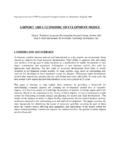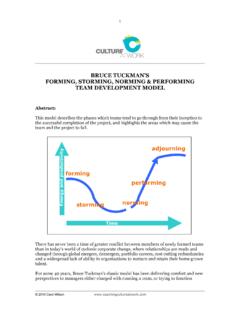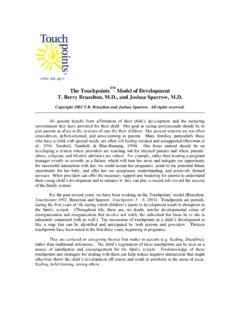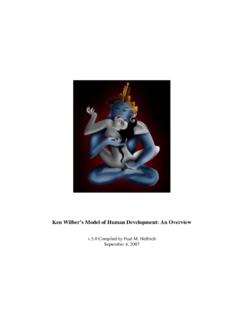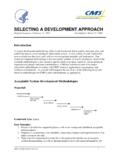Transcription of Professionalising purchasing in organisations: towards a ...
1 Professionalising purchasing in organisations: towards a purchasing development modelProf. Dr Arjan van Weele, Nyenrode University, Center for Supply Chain Management, Straatweg 25, 3621BG Breukelen, The Netherlands, +31-346-291211, and Drs Frank A. Rozemeijer,Institute for purchasing & Supply development , Eindhoven University of Technology, PoBox 513, PAV J-07, 5600 MB Eindhoven, The Netherlands, tel: +31-40-2472423, fax: Rietveld, Compendium purchasing Consultants, PO Box 209, 1400 AE Bussum, tel. 31-35-6938718,fax 31-35-6916148 ABSTRACTHow does purchasing develops as a discipline over time in large international organisations? What are the drivers andenablers behind the development of purchasing ? Is there an ideal growthpath for purchasing in organisations? Thesesubjects are discussed in this paper by, firstly, providing an overview of current literature and analysing the modelswhich have been published in management literature.
2 Based on our analysis we propose an integrated frameworkwhich may help practitioners in developing their future courses of action with regard to purchasing and supplystrategy and organisation . Currently, this framework is tested through empirical : purchasing development , strategy, structures in large companies nowadays are a lot different from what they were in the eighties orseventies, and they will, beyond doubt, be different in the future. Two decades ago concepts like purchasing portfoliomanagement, total cost of ownership, supplier-partnerships, early supplier involvement and cross-functional buyingteams were not known. Since then many new strategic and organisational concepts in the field of purchasing andsupply chain management have been developed. The professional development of the purchasing function inorganisations can be analysed from different angles and/or aspects.
3 It is reflected by the more differentiated way inwhich supplier relationships are managed today. From competitive bidding companies nowadays applydifferentiated supplier strategies such as co-operative buying and partnering (Burt; 1993). Another aspect, which isrelevant for purchasing 's professional development is the information technology which is being used. In this areaincreasing sophistication can be perceived (Stekelenborg, 1997).The way purchasing develops within a (manufacturing) organisation is the major concern of this paper. We setout in this paper how purchasing as a discipline may contribute to an organisation s long-term growth, itsstrategic position, and its overall competitiveness. It is hypothesised that changes within purchasing may beboth developmental and ad hoc. Supply shortages on the market, or other external, unforeseen events maycause fast and unplanned changes in purchasing strategy and organisation as well as in supplier relationships(Heberling, 1993).
4 We even hypothesise that the professional development of purchasing organisationally maybe set back, when external pressures on the company (gradually) disappear. Our research project is aimed attrying to test these challenging hypotheses and will try to find out whether purchasing development in practiceis the result of careful long term planning or the result of short term at organisational developmentOrganisational development (OD) can be defined as a response to change. It usually encompasses a complexeducational strategy intended to change the beliefs, attitudes, values and structure of organisations so that theycan better adapt to new technologies, markets and challenges (Child , 1981). OD may take differentforms: it may relate to continuous improvement (KAIZEN) aimed at improving the internal processes withinthe company, but it may also relate to improvement measures between subcontractors and their suppliers(supplier development or supplier alignment).
5 Continuous improvement is characterised by small steps whichare consistently conceived through a bottom-up, multidisciplinary team-based approach. OrganisationalDevelopment may also take the form of Business Process Reengineering (Hammer, 1993), which is aimed atrestructuring business processes in organisations, or Transformation Management, which is aimed at changingorganisational structures. These types of change management are much more top-down, expert to continuous improvement it has more an ad hoc character. If continuous improvement is one end ofthe continuum, crisis management (often conducted through interim-managers or outsiders that are broughtinto the organisation ) is the other end. This approach is often valid when drastic measures are required inorder to restore the balance between the organisation and its environment. As research evidence shows (Imai(1994)) Japanese companies tend to develop at the left side of the change-spectrum, whereas Westerncompanies seem to develop much more according to the right side of the spectrum (see Figure 1)Insert Figure 1 Organisational development and management of changeWe think that the literature on the theory of organisational behaviour and management of change is importantfor purchasing practitioners.
6 Based upon our discussions with many executives it is our impression thatpurchasing managers mostly rely on simple or intuitive rules of thumb and implicit knowledge aboutmanaging change in their purchasing organisations. There seems to be little awareness of theoretical insight onhow organisations develop over time (as has been described by among others Greiner (1972); Lievegoed(1993); Bolwijn en Kumpe (1992) . Insight and knowledge of organisational behaviour and organisationaldevelopment is important since it may lead to a better understanding of how purchasing may develop over timein an organisational context. Based on these theories we have tried to describe through a coherent, though(still) theoretical model how purchasing may develop organisationally within a (manufacturing) specifically our objective is to answer the following research questions: how does purchasing develop as a discipline or business function over time in large internationalorganisations?)
7 What are the drivers behind the professional development of purchasing in organisations? what dilemma's must be overcome in order to move from one stage to the next stage of development ? if there is one, what is the most appropriate growthpath for purchasing in organisations?Now that we have briefly discussed several ways on how theories on organisational behaviour anddevelopment may be used to describe purchasing 's organisational development , let s have a closer look at thetheories that have been, so far, most influential in the field of purchasing development . This has been thestarting point of our research. It is the focus of this and stages of organisational developmentIn order to be able to get an insight in the evolution of the purchasing function different purchasingdevelopment models have been analysed. Our findings are summarised in Figure 2. Authors and contributionshave been ranked in historical Figure 2 Contributions from literature on purchasing developmentFrom Figure 2 it can be concluded that since 1988 there has been a steady flow of ideas regarding thedevelopment of purchasing .
8 This probably reflects the growing interest of academics and particularlyconsultants for the integration of purchasing and supply management in the broader framework of businessand corporate strategic plans. All authors assume a stage-wise or stepwise development of purchasing 's have a closer look at the models which have been presented and let us appraise the major commonaltiesand differences: Integrated final stage: Most authors assume the existence of a final stage of excellence towards whichall improvement efforts should be directed. Almost all models show a final phase where purchasing isintegrated in the major lines of business. At this stage line management is actively involved inpurchasing strategies and tactics. Also at this stage, as it is assumed, purchasing processes areorganised around multi-disciplinary, team-based structures. purchasing s organisational status: Most models point out that purchasing firstly reports rather low inthe organisational hierarchy.
9 Next we may see some degree of centralisation, which in a business unitstructure will turn to some form of co-ordinated purchasing (where responsibility for purchasing policyresides within the individual business units) Supplier management. The development of supplier management is an other similarity in the differentdevelopment models. In the first stage supplier management seems to be reactive ( crisis management ).In the next phase, it becomes more proactive, and the last phase it becomes relationship management. Supplier relationships . Most authors assume that as purchasing moves through the different stages ofdevelopment relationships with suppliers will change. Starting with a purchasing department handlingmany suppliers at arms length . In the next stage, purchasing has reduced its number of suppliersconsiderably so that closer relationships with a smaller number (preferred) suppliers are able todevelop.
10 The final stage often shows that supplier relationships have turned into partnership type development models have been based on a limited set of parameters, such as: Top management commitment the degree to which top management shows active interest in and isactively involved in purchasing strategy and supply matters Functional leadership relating to the management style which is employed, the way change management isbeing applied (see paragraph 2 of this paper) purchasing strategy relating to the degree of formalisation with which plans have been made, the extent towhich purchasing strategies have been integrated in overall business planning, the actual contents ofpurchasing strategies and plans purchasing activities covering the extent to which the purchasing department is involved in productdevelopment, supplier selection, contract management, order handling en supplier evaluation.

